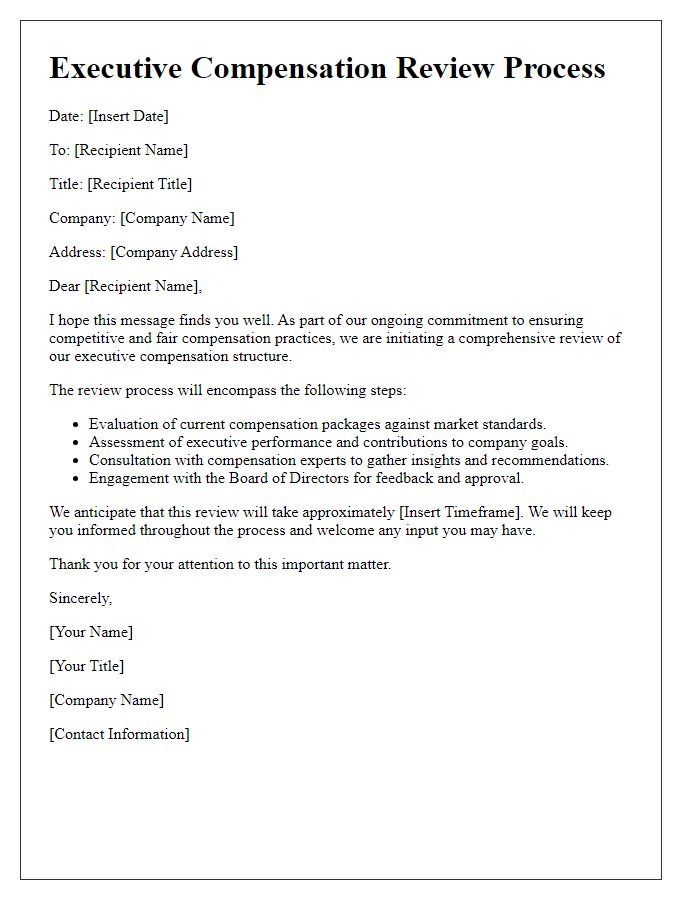When it comes to establishing fair and effective executive compensation agreements, clarity and transparency are key. These agreements are vital in aligning the interests of executives with those of the organization, ensuring that both parties are on the same page. By outlining the components of compensation packages, including salary, bonuses, and benefits, we can foster a culture of trust and accountability. Curious about how to create the perfect executive compensation agreement? Let's dive in!

Compensation Structure
Executive compensation agreements typically include a detailed compensation structure that outlines salary, bonuses, stock options, and other incentives. Base salary often reflects industry standards and ranges from $150,000 to over $1 million annually, depending on company size and executive role. Performance bonuses, typically 20-100% of the base salary, are tied to achieving specific financial targets or strategic goals outlined in annual reports. Stock options provide executives the opportunity to purchase company shares at a predetermined price, offering long-term financial incentives aligned with shareholder interests. Additionally, benefits such as health insurance and retirement plans are standard components of the overall compensation package, ensuring a comprehensive approach to attract and retain top talent in competitive markets.
Performance Metrics
Performance metrics in executive compensation agreements are crucial for aligning the interests of executives with those of the company's stakeholders. Key performance indicators (KPIs) such as earnings before interest, taxes, depreciation, and amortization (EBITDA) serve as quantitative benchmarks that executives must achieve to earn their full compensation. Metrics may include revenue growth targets, which could specify a percentage increase over the previous fiscal year's earnings, such as 10% year-over-year growth. Additionally, total shareholder return (TSR) can be evaluated against a peer group of similar publicly traded companies, emphasizing the competitive landscape. Another important metric, return on equity (ROE), measures the company's profitability relative to shareholders' equity, ensuring executives are focused on sustainable financial performance. Non-financial metrics, such as employee engagement scores or customer satisfaction ratings, can also provide a holistic view of executive performance. These metrics are often evaluated on an annual basis, with thresholds clearly defined in the agreement, ensuring transparency and accountability in achieving the stated objectives.
Equity and Benefits
Executive compensation agreements encompass critical elements such as equity and benefits designed to attract and retain top talent within an organization. Equity compensation typically involves stock options or restricted stock units (RSUs), linking an executive's compensation to the company's performance in stock markets, fostering alignment with shareholders' interests. Benefits may include health insurance, retirement plans, and performance bonuses, which vary significantly by industry and corporate structure, providing a comprehensive package that reflects the company's commitment to the executive's well-being. These agreements are crucial in establishing competitive advantages within sectors like technology and finance, where skilled leadership directly correlates to innovation and profitability. Legal compliance and clarity in these agreements are paramount, ensuring that all parties understand their rights and obligations under regulations such as the Securities Exchange Act of 1934 and Internal Revenue Code sections governing deferred compensation.
Employment Duration and Termination
Executive compensation agreements often include clear stipulations regarding employment duration and termination conditions to ensure accountability and transparency. Standard duration may range from two to five years, established upon the effective date of the contract, typically aligned with the strategic goals of the organization. Termination clauses cover various scenarios, such as voluntary resignation, which might necessitate a notice period of 30 to 90 days, or involuntary termination, which may include provisions for severance pay and benefits continuation for a defined period, often between six to twelve months post-termination. Additionally, terms could specify guidance on termination for cause, detailing acceptable grounds such as breach of contract, misconduct, or failure to meet performance metrics agreed upon at the outset, to protect the interests of the corporation. These elements ensure clarity and fairness in executive compensation structures and mitigate future disputes.
Confidentiality and Non-Compete Clauses
Executive compensation agreements often include critical components such as confidentiality and non-compete clauses that protect both the organization and the executive. Confidentiality clauses prevent the unauthorized disclosure of proprietary information, trade secrets, and business strategies, ensuring that sensitive data remains secure during and after employment. Non-compete clauses restrict the executive's ability to work for competitors or start similar ventures within a specified geographical area and time frame, often ranging from six months to two years post-employment. These legal stipulations are essential in safeguarding the company's competitive edge and intellectual property, often explicitly detailing the consequences of violations, including potential legal actions. Such agreements are integral to maintaining the integrity of high-level management positions and overall corporate governance, especially within Fortune 500 companies.













Comments